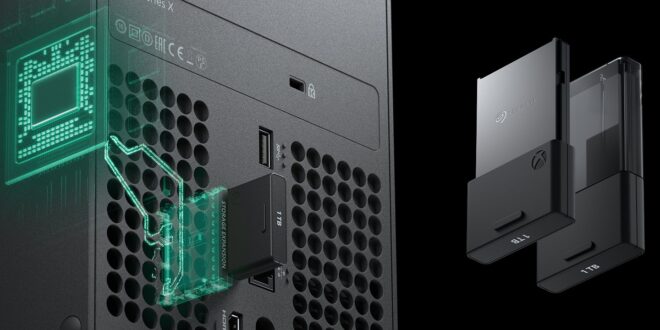While Mark Cerny’s recent talk on PS5 hardware was a tad dry for consumers – it was originally intended for a GDC audience of course – we were riveted. While the Xbox Series X had already announced its commitment to SSD storage, it was Cerny that really delved into what that might mean for developers.
Storage options have come a long way during the last two console hardware generations, at least in terms of capacity. At launch, the Xbox 360 optionally came with a 20GB hard drive, while the latest devices have comparatively whopping 1TB drives. Though install sizes are rising just as fast, to the dismay of many.
Capacity aside, the typical hard disk drive (HDD) has long been a problem. With a throughput of just 50MB/s (though even that is far from steady), the current standard drive is a huge speed bump, one that has forced developers into creative solutions to mask the issue – such as those super-tight gaps your character squeezes through between rooms.
SSDs, by comparison, are roughly one hundred times faster. That’s an exponential leap, the kind rarely seen in gaming hardware. So we ask some of the top technical minds at UK developers how they think the technology will change how games are made and how they play.
SCIENCE FRICTION

Modern games are big. For example the entirety of Call of Duty: Modern Warfare on PS4 is now pushing almost 200GB of data – largely textures and other assets to fill its numerous, sumptuous environments.
All that graphical detail may thrill gamers, but they pay for it elsewhere. The reality is that consoles have been struggling to keep up and that’s become a big issue, says Marc Fascia, VP of technology at Splash Damage.
“A lot of the friction in the process of playing console games comes from slow storage operations. Installing a game on current gen takes a long time, to a point where features like intelligent installers or pre-downloading games had to be introduced.
“Load times also add friction for players and this got worse as we went through the last two generations of consoles. The amount of game data grew much faster than the increase in speed in HDDs. Consoles now have more memory and filling it with data that comes from a slow drive would only take longer. This is not a sustainable situation and it’s going to be great to see things improve in that area.”
Scott Kirkland, Studio Director at Sumo Warrington, concurs: “If you have twice as much memory to fill with (non-procedurally generated) content, it would take twice as long to load it without a corresponding improvement in storage. By adopting SSD we get a significant increase in loading bandwidth, allowing more memory to be filled with higher quality, or more varied, content at a faster rate. We need to be mindful of the overhead of any load time processing of incoming assets. Fortunately next-gen consoles combine faster storage with faster processing!”
Kirkland continues by giving an example: “Reduced loading times mean that decisions on which content needs to be read can be made later and/or more/better content can be read. Think of Destiny’s transition areas such as tunnels. They can either become significantly shorter, allowing for faster transitions between types of areas with no significant improvement in content quality, or they can remain similar in length but allow for increased variety or quality of content when you emerge into the new area.”
Prasanna Jeganathan, technical director at Supermassive Games is also keen to put reduced friction front and centre: “The biggest initial impact will be a big improvement in loading times.” But he also notes that loading times are not necessarily bad. “Some may like a brief period before jumping back into a level. I would hope these high and lows would now be design choices rather than a product of hardware restrictions.”
BETTER BY DESIGN

At present, though, it’s clear that such hardware restrictions are impacting game design in numerous ways, though maybe not numerous enough for gamers, who are used to the same old tricks, as Clive Gratton, technical director at Creative Assembly, points out.
“For interior designs, we’ll no longer need to have to include long dog-legs, air locks and lifts to allow the next section of the level to stream in. Visible LOD (level of detail) popping when sniping will be a thing of the past and moving from one location to another in a massive world becomes almost instantaneous.
Such an impact has already been demonstrated by Sony in its Spider-Man SSD demo, allowing fast travel across New York to be genuinely fast, with the new location loading in almost instantly.
Splash Damage’s Fascia thinks such speed will change the very design ethos of many games: “Designers will likely have a better answer to this question, but my take is that it is going to encourage more devs to think of their game world as one seamless piece rather than discrete chunks with loading screens in-between.”
And he also believes that the speed will allow some more unusual approaches to flourish: “Some techniques like Quake Wars’ megatextures could resurface. Megatextures, also known as Partially Resident Textures, allow every object of the game to have its own unique set of textures, leading to richer, more varied and less repetitive visuals. To achieve this effect the engine constantly streams in and out the texture fragments it needs to render what is on screen and caches it. How fast the data can be streamed in is vital for such a system to work. In previous generations, it required a lot of very bespoke optimisation, but things could simplify drastically with faster drives. It’s interesting to see that both hardware vendors such as NVIDIA or AMD as well as Unreal have been doing work in this area lately.”
CROSSING THE STREAMS

And that’s just one way that the engineering behind the scenes could change radically, as the sheer speed of SSDs will blur previously stark lines.
Supermassive’s Jeganathan explains: “It may change memory strategies by treating the SSD space as slower RAM. This allows the data density for software to be higher. The churn on memory allocation in modern game engines would be higher, resulting in a need for more optimal approaches to memory allocation.”
Splash Damage’s Fascia talks about the upside of such an approach: “Faster drives will allow for better streaming and caching. Just keep the data you need in memory and evict what you don’t need any more, since fetching it again when needed is now fast enough.
“Systems like texture caches could be simplified thanks to this too. There is [currently] a lot of complex logic to figure out which textures you need or are going to need in the short term, and to make sure they are in memory by the time you need them. Faster reads could make the logic simpler as the data will become faster to get. Another way to use faster read and writes is to cache to disk the result of CPU intensive computation. So that you won’t have to do it again and you can instead just fetch the data.”
However, it’s not all a free dinner, he admits: “The flipside is that more dynamic memory usage like this is harder to debug, so this will also put an emphasis on better tooling and logging.”
PC GONE MAD
This all sounds incredibly beneficial, but most serious gaming PCs have had fast SSDs for some time, so why haven’t we seen the same benefits rolled out on that platform before now?
“I think scalability is paramount in the world of PC gaming and as much as possible, the game should adapt to the player’s machine rather than the other way around,” says Fascia.

“That being said, use of SSDs has been growing steadily and I think we will organically reach a point where it is safe to assume one is present on the player’s machine. We’re just not quite there yet.”
Supermassive’s Jeganathan agrees, saying: “It would depend if a developer adds the requirement to [the minimum spec]. SSD so far has been focussed on the fidelity of the experience rather than if you can do something or not. A product could still be a really good experience with loading screens, but generally that same product without loading screens is going to be better.”
Sumo’s Kirkland concurs: “With the PC platform being an inherently broad platform and players often enhancing their rigs incrementally, I don’t think we’d be able to stipulate an SSD for minimum spec – although it would doubtless be part of the recommended spec for a modern game.
“As PC developers, we have to maintain safeguards against slow loading and provide sufficient quality options to ensure that as many players as possible can have a great experience.
“That said, in a multiplayer scenario where there are load-dependent synchronisation points, there may well be merit to additional match-making filters such as ‘SSD only’ in order to minimise wait times amongst better equipped players.
THE WEAKEST LINK
And such arguments won’t just affect PCs, as we may be entering an era where console titles are as affected by the need to be backwards compatible as PC titles have always been. Aside from next-gen exclusives, of which practically none have been announced to date, console games will likely need to work on both current and old hardware for the time being, especially if developers and publishers want to maximise their profits.
“As a multi-platform developer, we may need to be mindful of lowest common denominator platforms,” agrees Sumo’s Kirkland. “Ideally we would avoid varying level design – including area transitions – for each platform, especially if there was a desire to support cross-platform play.
“However, the player experience will be far superior on next gen, with short load times, less popping of streamed assets or textures, etc.”
“With existing platforms likely to remain popular for some time, generation-spanning titles do need to balance a desire for increased variety and quality with delivering a consistent gameplay experience for all players. This means that outside of platform or generation exclusives, short term benefits may be
largely cosmetic and/or loading time biased.”
To which Fascia adds: “Streaming systems are inherently scalable so similar techniques could be used across the old and new generations of hardware. However, the player experience will be far superior on next gen, with short load times, less popping of streamed assets or textures, etc.”
CHANGE OF STATE
So while the SSD revolution may not be able to tear up the old rulebook quite yet, that’s not to say that it couldn’t yet bring radical change to the industry.
Creative Assembly’s Gratton sees the possibility of “different gaming experiences becoming a reality – super fast loading means that high-quality short form games can emerge as a genre. At present no-one wants to wait two minutes to boot into a game session that lasts one minute – but if that loading takes one second then this sort of game is now viable.”
That opens up the possibility of whole new genres, games that you might launch from the dashboard between other experiences, something closer to the booming hyper-casual market on mobile, but backed with huge processing and graphical power.
“In addition to loading, saving will be significantly faster with SSDs too.”
And Supermassive’s Jeganathan sees similar possible changes in usage patterns: “The user experience for playing huge games will mean you can potentially dip in and out as if they were mobile apps.”
Finally, it’s not just faster loading that SSDs will bring, as near-instantaneous saves could bring unconsidered benefits too, says Sumo’s Kirkland.
“In addition to loading, saving will be significantly faster with SSDs too. Whether this be a less invasive autosave, a quick manual save, fast suspend (for subsequent resume) or a more significant and continuous serialisation of state to accommodate high-fidelity live rewind.”
He notes that this could further allow games’ exploration of time control: “Prince of Persia and the Sands of Time, Braid, various racing games, Blinx the Time Sweeper… this can only have a positive experience on gaming!”
And finally, Kirkland notes a possible usage for esports presentation as well: “In a racing game which streams higher fidelity assets around the player’s vehicle (which moves in a largely predictable manner), features such spectating – where you want to reload a considerable amount of data on switching between players located at different points along or around a track – can become more responsive with a corresponding benefit to esports presentation.”
FILLING THE OCEAN
More data, delivered more quickly, sounds fantastic. However, the improved technology, for next-gen exclusives at the very least, will come with an improved appetite for development resources, notes Kirkland.
“It’s worth noting that experience-affecting increases to variety and quality of content – when tackled by brute force – would likely equate to increased development costs,” he warns.
“We all need to be looking for smart ways to optimise content creation, and the refinement or reuse thereof, to help us make this new generation of games as accessible as possible.”
Or to put it another way, in the future you can expect games to load a lot quicker, but don’t expect developers to make them a lot quicker because of that.

 MCV/DEVELOP News, events, research and jobs from the games industry
MCV/DEVELOP News, events, research and jobs from the games industry




